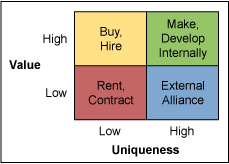
Should companies hire ready-to-go Black Belts, develop them internally or use a Black Belt from a consulting company? It is a question that many companies wrestle with during the early stages of deploying Six Sigma. The obvious trade-off is between the time it takes to develop one’s own talent and the time it takes to get results in the first Six Sigma projects. To sustain and continuously improve, a company needs the internal talent, yet the first projects have to bring substantial results quickly as references for convincing the late adopters in the company that Six Sigma is worthwhile.
A Decision Filter
A useful filter for examining the buy-make-rent dilemma is the same as used in any people development and staffing challenge. Investigate these two dimensions:
1. The value of the human capital for the organization.
2. The uniqueness of this resource for the organization.
Value means the extent to which the position is really crucial for the company strategy, having a clear impact on its success. Consideration is to real core assets, not to “nice-to-have” resources. The value of human capital is dependent on its potential to contribute to the competitive advantage or core competence of the firm.

Uniqueness means the scarcity in the labor market of the skills or capabilities in question. How specific are the competencies to the organization? How hard is it to replicate or duplicate the specific know-how from the outside?
Applied to Black Belts, this filter suggests a different staffing strategy depending on how the questions are answered.
Regarding value, most practitioners would agree that if one is serious about Six Sigma, it is linked to strategic change. While that may be the desired positioning of Six Sigma, it does not usually start out that way. For the moment, assume that Six Sigma is seen by the business leaders as strategic.
Labor Market Maturity
The decision then comes down to a question of uniqueness. For example, in Italy, Six Sigma is an emerging phenomenon so there are fewer experienced Black Belts available on the job market. Where the labor market is not very developed for those skills, they are scarce and the best solution would be to develop talent internally.
Where the market is more developed, buying talent is more of an option. For example, in the United Kingdom Six Sigma is a mature phenomenon with a large pool of Black Belt talent. Many have “graduated” from companies now in their third or fourth year of deployment. In part, uniqueness is a function of the maturity of Six Sigma in the local job market.
Navigating Corporate Culture
Another way to look at uniqueness is from the demand rather than the supply side. How unique is the corporate culture in which a Black Belt must work and into which he or she must integrate to achieve lasting results? How high is the probability of a not-invented-here syndrome whereby the business rejects the transplant of talent coming from the outside? If business leaders have positioned Six Sigma as not only strategic but also about helping drive a cultural change, then a Black Belt’s ability to navigate the current culture while pulling it in a new direction is paramount. As the saying goes, “Change is a door that can only be opened from the inside.” That suggests that the more unique and strongly developed a company’s culture, the better off a company is in developing its own talent. In that case, it is easier to teach someone the Six Sigma toolkit than it is to help them learn the company’s culture.
The Early Stages
What happens if the Six Sigma professionals are not yet considered strategic by the majority of the opinion leaders in a company? This is common in companies where Six Sigma is seen as just another quality initiative, where previous failures created a cynical approach toward improvement programs. Quick results are mandatory to increase momentum. This scenario calls for taking experienced Six Sigma resources from an external source, such as a management consulting firm or independent contractors. The decision is linked again to the uniqueness of Six Sigma skills in a specific labor market. Wide availability of external resources means choosing the rent alternative, contracting the Black Belts on a one-to-one transactional basis for non-strategic work.
Considering positions requiring more unique skills, such as the role of Master Black Belts in difficult Six Sigma deployments, the best option is the external alliance – a partnership with a professional services firm which provides highly skilled resources active for almost 100 percent of their time for a specific client. While leaving the driving of specific projects to internal Black Belts, the external Master Black Belts play a coaching role behind the scenes. As momentum builds and project results increase the strategic value of the Six Sigma initiative, Master Black Belts can be developing internally to replace external resources. This helps ensure sustainability.
Conclusion: Enough Talent to Get Results
The decision of whether to buy, make or rent Black Belt talent is one that every company deploying Six Sigma on a significant scale faces. The choice is guided by the uniqueness and value of the Black Belts. If positioned strategically and in a mature market for Six Sigma talent, hiring is a viable option. However, a company must consider whether it is easier to teach a person Black Belt skills or how to navigate the company’s culture. In less mature markets where Six Sigma is positioned strategically, internal development is the best option. Consider an alliance with an external Six Sigma consulting firm for Master Black Belt resources as a way to accelerate the development of internal resources in the early stages. Whatever strategy one uses for Black Belts, the key is having sufficient internal talent to sustain operational results, accelerate improvement and create a high-performance culture.